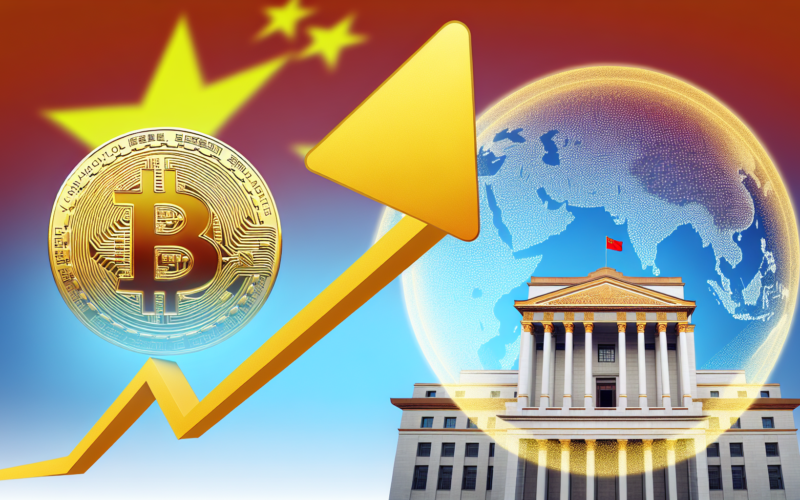Bitcoin rises as Treasury’s Bessent tempers China trade fears. Ethereum and Solana also up. Market volatility to watch. #Bitcoin #Crypto #Finance
- Introduction: Bitcoin and the Trade Storm – A Closer Look
- The Historical Context: Bitcoin’s Journey Amid Economic Policies
- Main Insights on Bitcoin’s Market Movements
- Challenges in Navigating Bitcoin’s Volatility
- Future Outlook: What Lies Ahead for Bitcoin and the Crypto Market?
- Final Reflections on Bitcoin’s Role in Global Finance
Introduction: Bitcoin and the Trade Storm – A Closer Look
As the world’s most prominent cryptocurrency, Bitcoin often finds itself at the center of financial discussions, especially during times of economic uncertainty. Recently, Bitcoin’s price movements have been closely tied to the evolving U.S.-China trade negotiations, with investors keenly observing every twist and turn. This article delves into Bitcoin’s recent price surge amid the backdrop of shifting trade policies, exploring its broader implications for investors and the cryptocurrency market.
The significance of these price movements cannot be understated. As global markets fluctuate, Bitcoin’s behavior provides insights into investor sentiment and broader economic trends. This article will unravel the complexities behind these dynamics, exploring how recent statements from U.S. officials have impacted not only Bitcoin but also other major cryptocurrencies like Ethereum and Solana. By understanding these trends, investors can better navigate the cryptocurrency landscape amid geopolitical uncertainties.
The Historical Context: Bitcoin’s Journey Amid Economic Policies
Bitcoin, since its inception, has been a beacon of innovation and disruption in the financial world. Initially created as a decentralized alternative to traditional currencies, Bitcoin has evolved from a niche digital asset into a significant player in global finance. Its journey has been marked by volatility, regulatory challenges, and increasing institutional acceptance.
In recent years, Bitcoin’s price behavior has often mirrored broader economic and geopolitical events. The U.S.-China trade tensions have been a prime example, with tariffs and trade negotiations influencing market sentiments. Historically, Bitcoin has been seen as a hedge against traditional financial market instability. This perception has been reinforced as investors seek refuge in digital currencies during times of economic uncertainty.
The ongoing trade war between the U.S. and China has added another layer of complexity to Bitcoin’s story. As tariffs have been imposed and negotiations fluctuate, Bitcoin’s price has shown notable responsiveness, reflecting its role as a barometer for investor sentiment toward economic policies. Understanding this backdrop is crucial for comprehending Bitcoin’s current market dynamics and its potential future trajectory.
Main Insights on Bitcoin’s Market Movements
Bitcoin and Trade Policies: A Symbiotic Relationship
Bitcoin’s recent price surge can be attributed to several key factors, with U.S.-China trade negotiations playing a prominent role. The latest statements from U.S. officials, including President Donald Trump and Treasury Secretary Scott Bessent, have provided mixed signals, creating a volatile environment for investors.
The Impact of Tariff Announcements
President Trump’s remarks about substantially reducing tariffs on China have sparked optimism among investors. This optimism was reflected in Bitcoin’s price, which saw gains despite earlier dips. The market’s reaction underscores Bitcoin’s sensitivity to geopolitical developments, highlighting its role as a hedge and speculative asset.
Treasury’s Tempered Expectations
Treasury Secretary Scott Bessent’s comments have also influenced market perceptions. By tempering expectations of immediate tariff reductions, Bessent introduced a layer of uncertainty, which initially caused fluctuations in Bitcoin’s price. His statements at a closed-door summit and subsequent public remarks have illustrated the complex interplay between economic policies and cryptocurrency markets.
The Broader Cryptocurrency Market Response
Bitcoin’s movements have had a ripple effect across the broader cryptocurrency market. Ethereum and Solana, for instance, have experienced notable gains, reflecting the interconnectedness of the crypto ecosystem. As cryptocurrencies become more integrated into financial markets, their price responses to global events will likely continue to align with broader economic trends.
Investors’ Reactions: A Mixed Bag
Investor sentiment has been a critical driver of Bitcoin’s price. While recent developments have provided some relief, the underlying volatility suggests that market participants remain cautious. On-chain analytics and trading volumes indicate that while some investors are capitalizing on short-term gains, others are adopting a wait-and-see approach, anticipating further developments in trade negotiations.
The Complexity of Predicting Market Movements
One of the key challenges investors face is the inherent volatility of Bitcoin. While the cryptocurrency offers opportunities for significant gains, it also poses risks due to its unpredictable price swings. The recent trade-related volatility underscores this challenge, as investors must navigate a landscape shaped by both economic policies and market sentiment.
Regulatory and Geopolitical Uncertainties
Regulatory developments and geopolitical tensions add another layer of complexity to Bitcoin’s market dynamics. As governments worldwide grapple with how to regulate cryptocurrencies, investors must stay informed about potential policy changes that could impact market conditions. Similarly, geopolitical events, such as trade negotiations, can create rapid shifts in market sentiment, requiring investors to remain agile and informed.
Future Outlook: What Lies Ahead for Bitcoin and the Crypto Market?
Emerging Trends and Predictions
Looking ahead, several trends and predictions are likely to shape Bitcoin’s future. As trade negotiations between the U.S. and China continue, Bitcoin may continue to serve as a barometer for market sentiment. Additionally, the increasing institutional adoption of cryptocurrencies is expected to provide a stabilizing influence, potentially reducing volatility over time.
Opportunities for Innovation and Growth
The cryptocurrency market is poised for further innovation and growth. As blockchain technology matures, new use cases and applications are likely to emerge, enhancing the utility and adoption of digital currencies. Investors have the opportunity to capitalize on these developments by staying informed and strategically positioning themselves in the market.
Final Reflections on Bitcoin’s Role in Global Finance
In conclusion, Bitcoin’s recent price movements amid U.S.-China trade speculations highlight its evolving role in global finance. As a digital asset, Bitcoin offers both opportunities and challenges for investors, serving as a hedge against traditional market instability while also reflecting broader economic trends.
For investors, understanding Bitcoin’s dynamics requires a multifaceted approach, considering geopolitical developments, regulatory changes, and technological advancements. By staying informed and strategically navigating the market, investors can leverage Bitcoin’s potential while managing its inherent risks.
As Bitcoin continues to influence and be influenced by global financial systems, its significance as a transformative force in the world of finance is undeniable. Whether as a hedge, a speculative asset, or a tool for innovation, Bitcoin’s journey is far from over, promising further developments and opportunities in the years to come.











